Today’s post is Part 4 in my series that began on May 16, 2018 concerning the recently concluded exhibition of extraordinary egg tempera paintings by the Dominican friar Beato Fra Angelico. The exhibition was held at the Isabella Stewart Gardner Museum in Boston, Massachusetts during the Spring of 2018 and was entitled Fra Angelico – Heaven on Earth.
Nathaniel Silver, Associate Curator of the Collection for this exhibition, includes in his book, Fra Angelico – Heaven on Earth, articles by eleven scholars. Each paper is a quality contribution to scholarship. There is one article authored by Chiara Pidatella, entitled “The Provenance of the Four Reliquaries for the Church of Santa Maria Novella.” It clarifies and answers the confusion surrounding the provenance of the four reliquaries. Ms. Pidatella has written an important paper in that it compiles the documentary evidence that proves that the four sacred images within the reliquaries in the sacristy of the Church of Santa Maria Novella in Florence, were painted by Fra Angelico. These reliquaries and other Angelico masterpieces were on display in the Gardner Museum.
A reliquary is an ornate elaborately constructed box, frame, etc. that is made of wood or precious metals and contains the remains of an individual or multiple saints. These remains may be small or large particles of bone, hair, etc of the deceased saint. Depending on the design of the frame the openings for the relics are contained in the top or bottom, and in the center if it is a box with lid. You can see the potential opening for the relics at the top of the frame in The Dormition and Assumption of Mary. It would be within the top circle that is vertically sliced in the center, the relics would be put in that small opening behind “the doors.” It should be noted that Colnaghi & Co. built a new frame for that painting in 1899. I presume they were loyal to the original design of a gabled early Renaissance reliquary, and that the vertical slice is actually an opening for the relic(s).
The reliquaries in the exhibition are embellished with four extraordinary paintings of events in the life of the Blessed Virgin Mary. Ms Pidatella says that “The fact that the saints whose relics they [the reliquaries] contained are not explicitly named suggests that the relics were of minor importance, especially in comparison to others mentioned in the same documents and described with great precision (particularly those decorated with gemstones and precious metals). The third inventory also confirms that all four reliquaries stayed together in the sacristy until at least 1772″ [Pidatella, p. 25].
The history of the movements of the four reliquaries is interesting. I won’t go into the historic details yet one incident deserves mentioning (I recommend that you purchase the book, Fra Angelico – Heaven on Earth, 2018, Gardner Museum, and Paul Holberton, London). The incident concerns the events of the early 19th century when the French government was required (under orders from Napoleon) to make an inventory of Italian artworks. The result being the French government took a very hard stand in relation to Italian art. Ms. Pidatella mentions their belief “that only France deserved to exhibit works from the most important moments in the history of art” (emphasis mine) [Pidatella, p. 27]. Pretty cheeky.
While three of the reliquaries remained in Florence, the Dormition/Assumption of Mary reliquary (one of four seen below) made its way into a collection of an English family headed by Rev. John Sanford (1777 – 1855; he was the chaplain to the Duke of Cambridge, brother of the British King George IV). This acquisition occurred in the early 19th century; however economic difficulties led to Sanford’s daughter, Anna Horatia Caroline Methuen, to put this Angelico painting on the market. When this occurred Bernard Berenson recommended Isabella Stewart Gardner of Boston to purchase the piece, which she ultimately did in 1899, for £4000 [Howard, p. 18, Fra Angelico – Heaven on Earth]. The Dormition and Assumption of Mary painting then became the first Fra Angelico to be displayed in the United States. Its current frame (that you will see below) was commissioned by Colnaghi & Co.(art dealers) in 1899. Their focus was to frame it in its original gable design {Howard, p. 18-19, ibid].
It is my privilege to present to you my quickly snapped photos of these masterpieces of the four reliquaries (through the courtesy of the Isabella Stewart Gardner Museum) . I will also provide my photograph of the back of one of the reliquaries to show you the wooden panel on which the egg tempera paint was applied. You will see that the panel was covered with a decorated piece of paper-like parchment. The reliquaries are approximately 24 inches tall by 15 inches wide.
The Annunciation and Adoration of the Magi (painted 1426-27) egg tempera and gold on wood panel. This frame is not slightly tipped to the right in reality. It was my attempt to snap a photo before someone stepped in front of me; I didn’t realize the photo was tipped at the time!



The above two are closeups of the Annunciation and Adoration. Slight tipping resulting from a quick snap occurred here, too. The green squares to the left of Mary’s head are not part of the painting. I did not use a flash. I don’t know what they are, possibly security lights. Notice the extraordinary grill work in back of the Virgin Mary, the angel Gabriel, and the Magi.
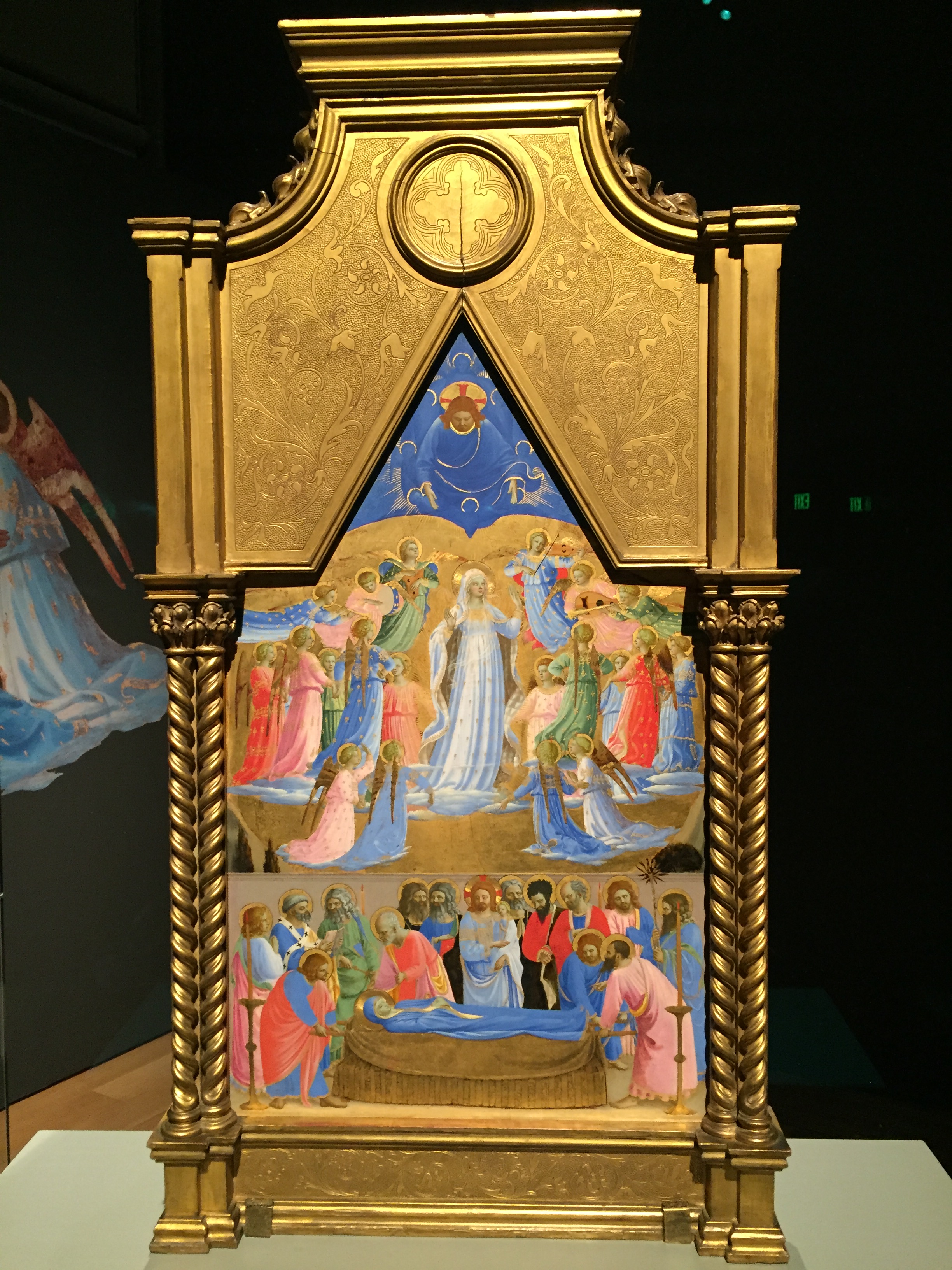
The Dormition and Assumption of Mary (1433-34, egg tempera and gold on wood panel). Purchased by Isabella Stewart Gardner in 1899, making it the first Fra Angelico painting in America. The painting shows in the lower section the Dormition (falling asleep, death, and above it the resurrection of Mary, the Mother of God ( that is, Mother of Jesus’ human nature) and her simultaneous Assumption into Heaven. The angel, dressed in a blue garment to the left of the frame, is one of a number of larger than life size posters that graced the black walls surrounding the exhibit. These poster angels were copied from Fra Angelico’s paintings. They provided a dramatic effect to the entire exhibit.
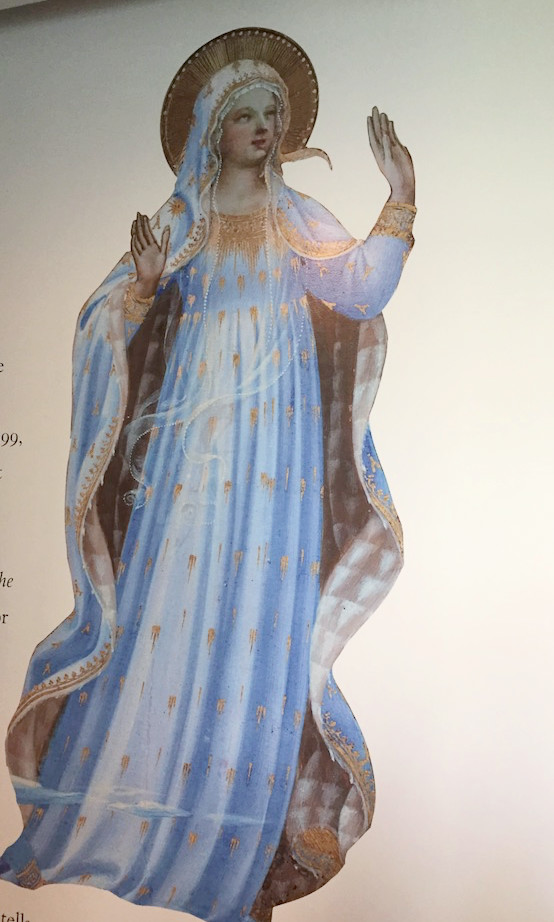
The above is a closeup of Mary which has also been expanded into a larger than life size poster image found in the above Assumption painting. This image was the first you saw as you rounded the second floor stairs into the exhibit at the Gardner Museum. It was taken from the above reliquary on the Dormition and Assumption of Mary and introduced visitors to the beauty of the exhibit.

The Coronation of the Virgin (1429). The lower image within this reliquary is contained in a small rectangular panel called a predella. It shows the Adoration of the Christ Child by Mary, St. Joseph, and six angels. It also is completed in egg tempera, gold, on a wooden panel. You see more poster angels taken from the Dormition and Assumption of Mary painting in pink and blue garments to the right of this reliquary on the black walls of the exhibit.
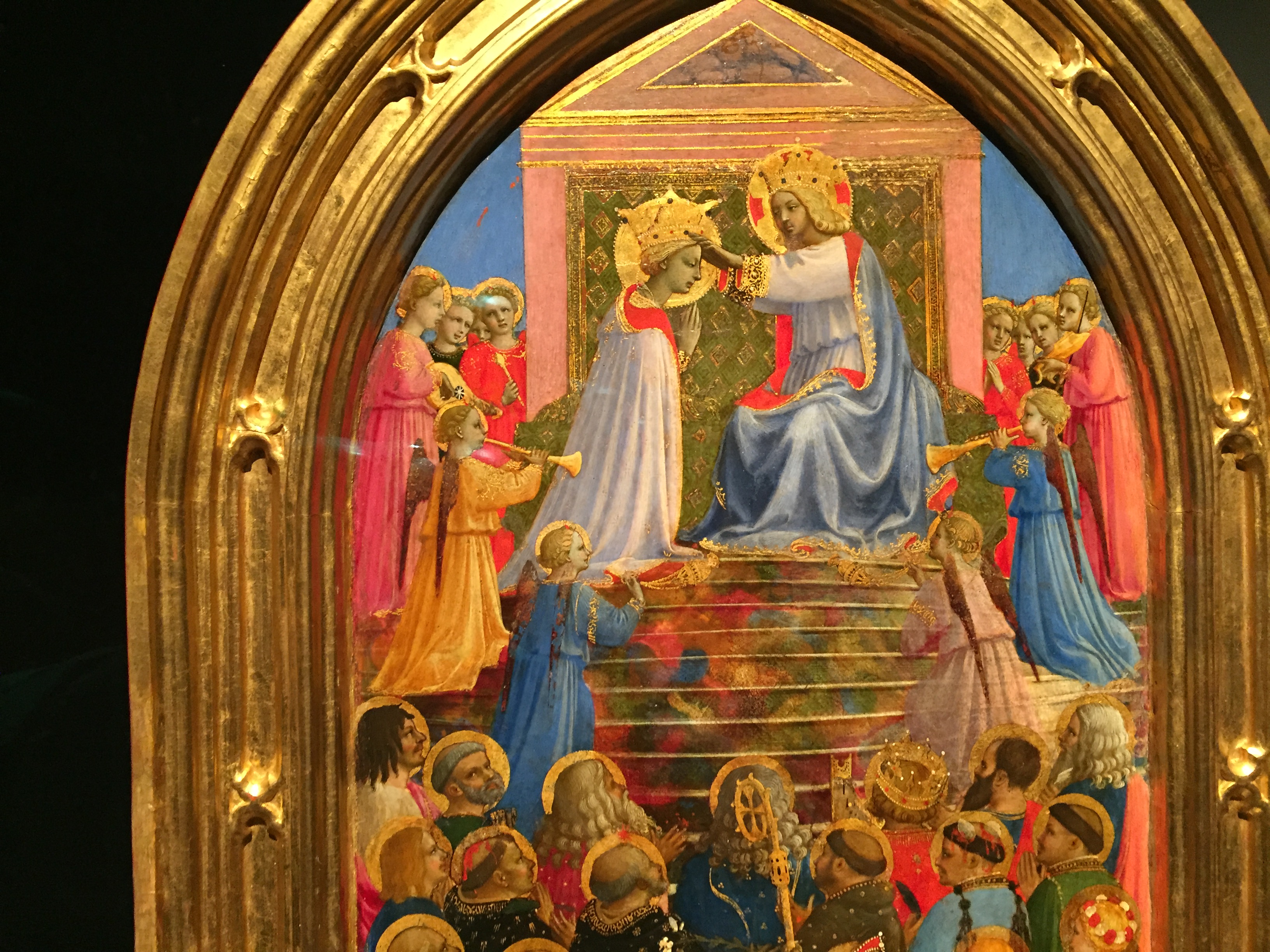
This is a closeup of the Coronation of the Virgin found within the above reliquary. Below are gathered a group of saints. The saint looking over his shoulder at the viewer near the extraordinary translucent stairs is Saint Peter holding the keys of Heaven. St. John the Baptist is on his left. Dominican saints, St. Peter Martyr and theologian St. Thomas Aquinas are also present, St. Francis of Assisi showing the stigmata in his hands, two deacons (St. Stephen, the first martyr (protomartyr), and possibly the deacon St. Benjamin, and some Old Testament prophets. St. Thomas Aquinas (above within the bigger photo) is looking at the viewer. He is situated next to a pope (the Benedictine Gregory the Great?), possibly placed in that position because both Aquinas and the pope were not martyrs.

The Madonna della Stella (The Madonna of the Star, 1433/34). Within the predella are the major saints of the Dominican Order (Order of Preachers). Saint Dominic (middle) flanked on the right by St. Thomas Aquinas and on the left by Saint Peter Martyr. The small circular photo of the Church of Santa Maria Novella on the back wall of the exhibit accidentally was included in my quick snap of this picture. It is interesting that it appeared, I did not plan it. It is the church that the four reliquary paintings were originally housed before they were split up during the last two and one-half centuries. Presently the Gardner Museum has the Dormition/Assumption of Mary reliquary staying in its collection and the other three will be returned to the Museo San Marco in Florence, Italy.

Closeup of the Madonna della Stella, showing the symbolic colors of the garments worn by the figures. The color blue represents divine attributes, which in the Blessed Mother’s case, represents the belief that she was always immaculate – without sin – and that the Holy Spirit “overshadowed” her resulting in the Incarnation taking place within her physical body. The presence of her immaculate nature was within Mary from the moment of her conception. The Latin Rite, the Eastern Rites in union with Rome, the Coptic Church, and the Orthodox Rites believe that Mary is not God, or a goddess. All of these Rites and Churches do not worship Mary; she is venerated by them. Worship and veneration are two very different concepts; they should never be equated.
The color red of Mary’s inner cloak (as well as Jesus’ outer cloak) represents their human nature. The orange trim of her cloak represents the specific spiritual illumination, and self knowledge, of her status as the Mother of Jesus’ human nature, not His divine nature.
With the two lower angels you notice that the blue/red colors are reversed. The inner cloak is blue representing their spiritual illumination and unique qualities/functions, yet, their outer cloak is red. This is done because Fra Angelico represents them all with human features, but, in the case of the two lower angels he represented their outer cloaks as red. I can place no other interpretation on it other than to say that because Jesus and Mary were resurrected from the dead, and have new physical bodies (with unique and specific qualities) the angels dressed in red outer cloaks may be serving Mary’s physical needs (whatever they may be) in Heaven. Heaven is viewed as both a physical (while different from ours) and a spiritual dimension.
As you know, angels are spiritual beings living within the divine atmosphere of Heaven. According to the Latin Rite (Roman Catholic) and other Rites, there are nine “choirs” of angels; each choir possesses specific attributes and functions. Fra Angelico may be distinguishing one “choir” from another through the different colors of the angels’ garments. Angels are pure spiritual beings; they do not have human features or bodies. They are represented that way in Latin and Greek Rite paintings, and some of them in the Holy Scriptures, in order to give the observer/reader a way to relate and understand their functions.
The Dominican Order was keen on expressing the theology of illumination as expressed in the Blessed Mother, their founder – St. Dominic (who illuminated Europe with his sermons against heretics) – and the illumination of the doctrines and dogmas of the Catholic faith provided through the writings of 13th century theologian St. Thomas Aquinas.
For Mary, Fra Angelico expressed that illumination through the orange pigment of Mary’s inner garment and the extraordinary gilding of the rays of light emanating from Mary and Jesus’ bodies. Notice that Fra Angelico shows the love between the two by having the child Jesus place His head close to His Blessed Mother as if He is about to give her a kiss with the Madonna lovingly holds Him.

Closeup of the Madonna della Stella; also showing a lovely lavender angel on her left.

The back of one of the reliquaries showing the structure of the wooden panel, and its decorated paper covering. On the front Fra Angelico applied a base coat of gesso, and then his egg tempera paints and gilding.
I hope you enjoyed viewing my four part series on this extraordinary work by Beato Fra Angelico – Fra (Friar) Giovanni di Fiesole. My deep gratitude to Peggy Fogelman (Director), Nathaniel Silver (Associate Curator) and the very talented staff of Boston’s Isabella Stewart Gardner Museum for bringing these masterpieces to America. For my wife and I it was a once in a lifetime experience. Congratulations to them and my sincere thanks, too.
I will be featuring some of the remaining single paintings within this exhibition at appropriate times during 2018-19. Some of the remaining Fra Angelico images from this exhibit are the marriage of St. Joseph and the Blessed Mother, the Deposition (taking down) of Jesus from the Cross, another painting of the Dormition of Mary, and events in the life of of Saints Cosmas and Damian.
June 12, 2018
© Deacon Paul O. Iacono 2011-2018 – text and photos. Photos were taken through the courtesy and generosity of the Isabella Stewart Gardner Museum, Boston, Massachusetts, USA. I took the photos with an iPhone 6, no flash.


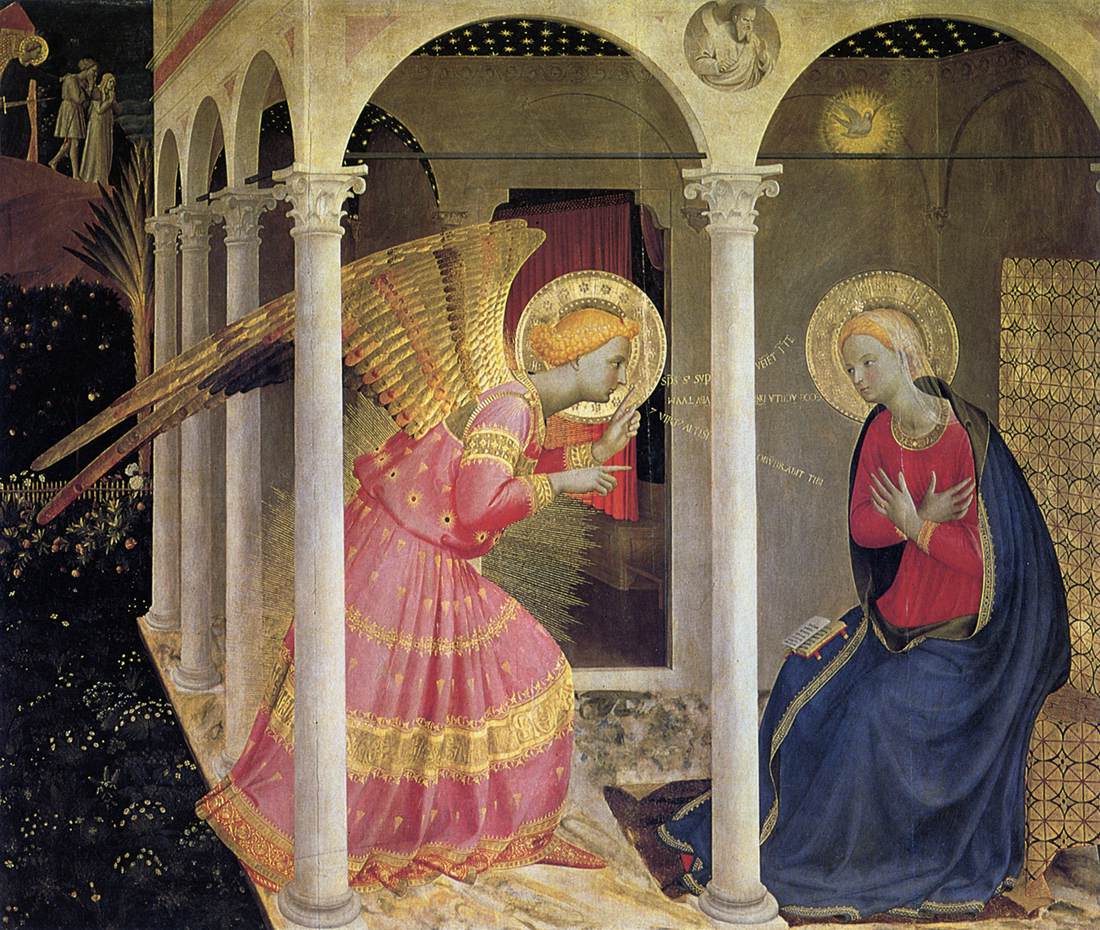
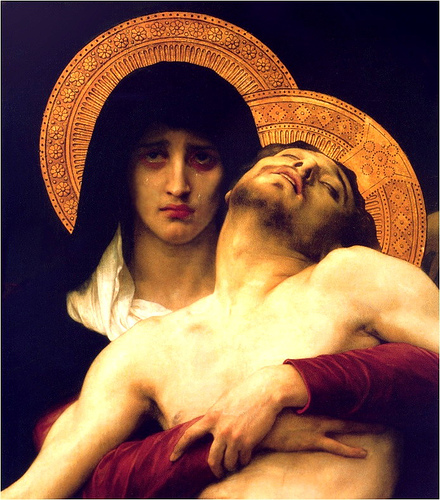









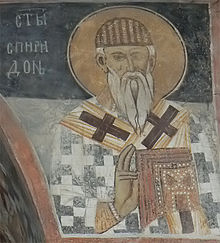






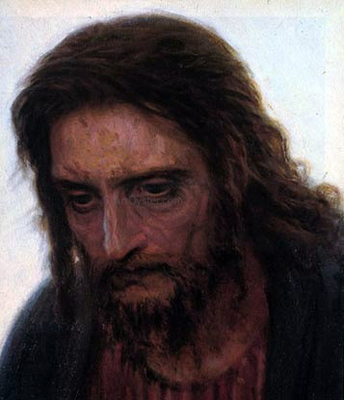






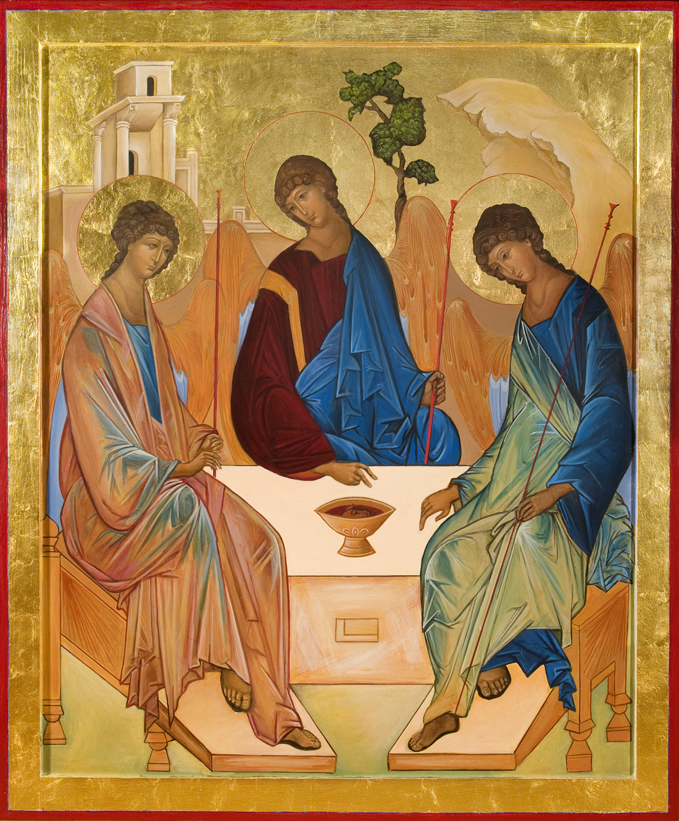













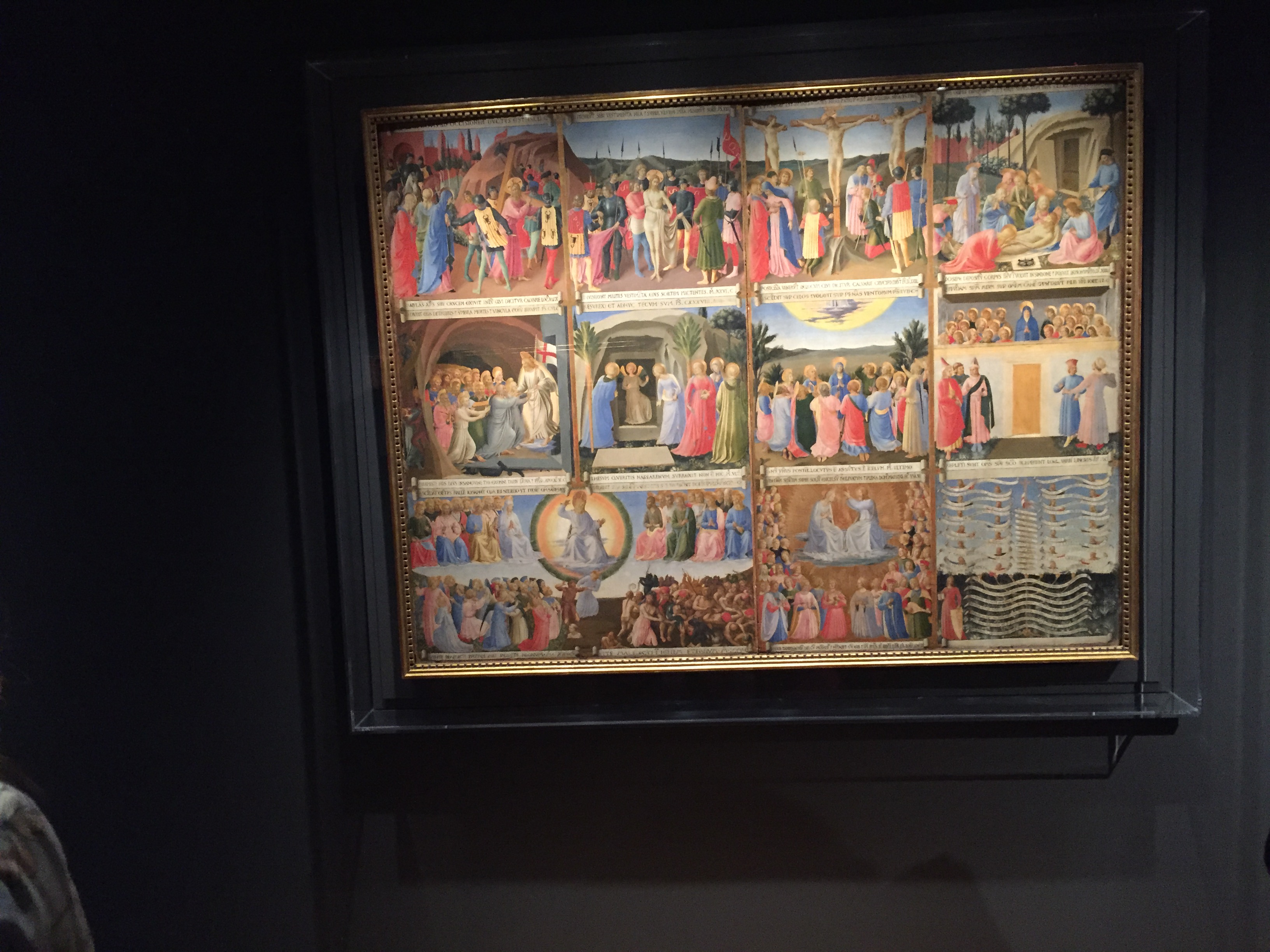

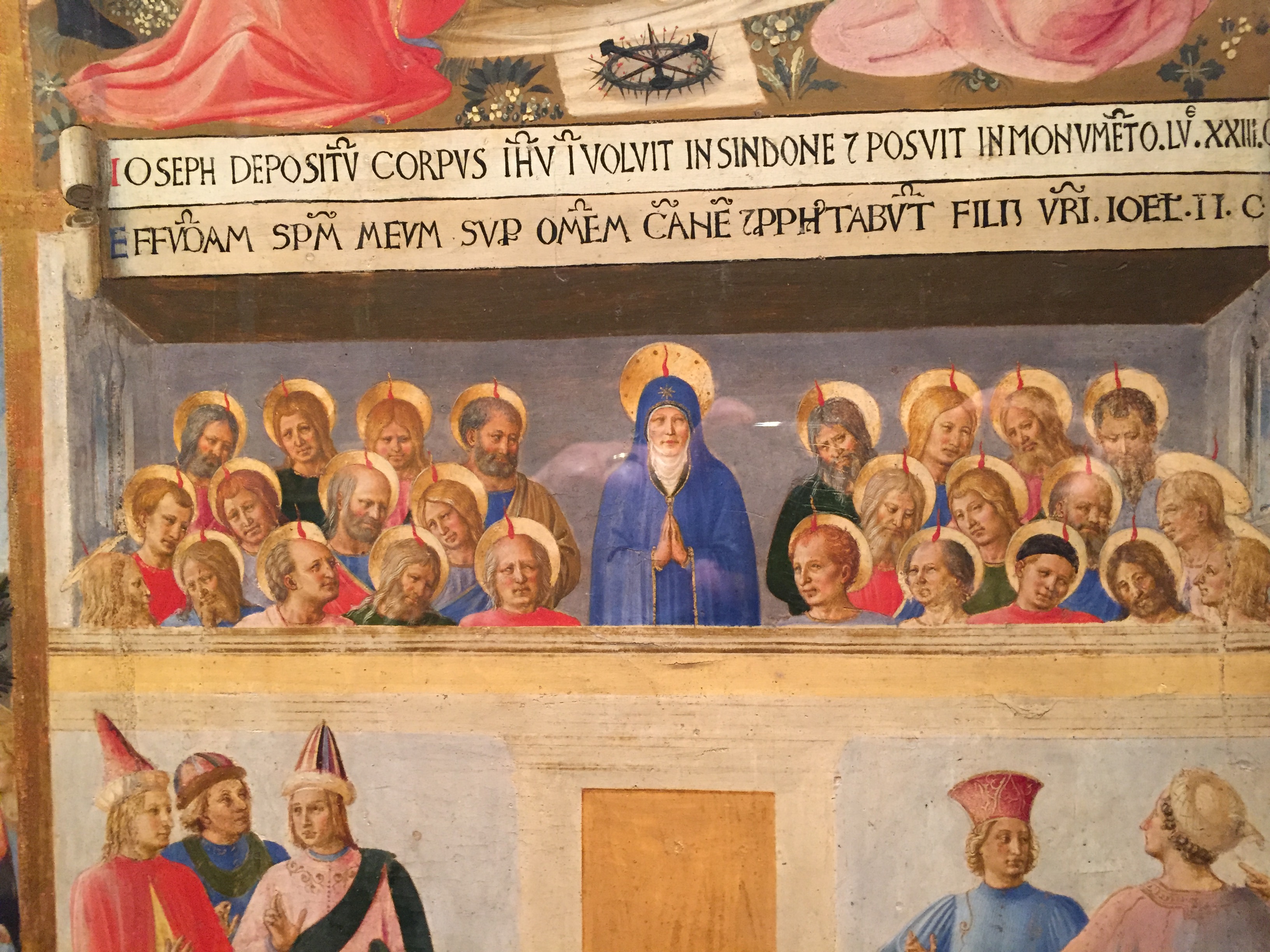 The above photo is one of the thirty-six panels describing events of the New Testament, in this case the Coming of the Holy Spirit at Pentecost. Notice Jesus’ mother Mary at the top center of the image with the Apostles and disciples (Peter is on her top right, and John is on her top left). They are receiving the Gifts and Fruits of the Holy Spirit symbolized by the tongues of fire. A curious crowd gathers below the upper room as described in the Acts of the Apostles.
The above photo is one of the thirty-six panels describing events of the New Testament, in this case the Coming of the Holy Spirit at Pentecost. Notice Jesus’ mother Mary at the top center of the image with the Apostles and disciples (Peter is on her top right, and John is on her top left). They are receiving the Gifts and Fruits of the Holy Spirit symbolized by the tongues of fire. A curious crowd gathers below the upper room as described in the Acts of the Apostles. 

“Paul, your protestations begs the question, do pagans go to Heaven? If so, why? If not, why not?” from Bernard Gallagher
These are excellent questions.
Before I attempt to answer them my readers should understand that I am a committed and Traditional Roman Catholic. His questions will be answered through the lens of the teachings of my Faith. That Faith is based on a foundation of Holy Scripture, Sacred Tradition, and two thousand years of Catholic scholarship.
Allow me to also mention that we need to understand that two Councils of the Church, the Councils of Orange and Trent (1000 years later), are critical in forming a correct answer to Mr. Gallagher’s questions. The Councils of Orange are significant (both of them were held in the city of Orange in Southern France, AD 441 and 529). The more important Second Council of Orange’s episcopal deliberations were sent to Rome and approved by Pope Boniface II in AD 531. That Council specifically proclaimed that everyone (who has reached the “age of reason”) is given sufficient Grace to be saved from eternal damnation. God will give, and has given all people, Actual Grace. If a person accepts and acts on that Grace, they will be saved.
What is Actual Grace? Actual Grace is an admonition by God for a person to correct their way of life, desire, search after, and make the sincere effort to obtain the Sanctifying Grace provided by the Catholic Church. The key action which achieves salvation and eternal life with God is the Holy Sacrament of Baptism. This allows the person to enter into God’s family. The Sacrament of Baptism removes Original Sin from an individual’s soul and enables it to receive additional Sacramental Sanctifying Grace. All Grace enables a person to become holy in God’s eyes. The other six Sacraments flow from the waters of Baptism. Pope Pius 9th (papal reign 1846 -1878) proclaimed that it would be extraordinary for an unbaptized person to achieve the eternal salvation and reward of Heaven.
First principle,
a) The Roman Catholic Church, the ethnic church Rites that are in union with Rome, the Greek and Russian Orthodox Churches, and some of the Protestant churches say that Jesus Christ, is the Word of God, the Son of the Father, begotten not made and consubstantial with Him. He is the Messiah, the Savior. His human life, ministry, passion, death, and resurrection redeemed mankind from their sins. His divinity is expressed through His position as the Second Person of the Blessed Trinity.
b) He is known to mankind through the historical Gospels and Epistles of the Apostles, the witness of His Mother, the Virgin Mary (especially at her apparition at Fatima, Portugal in 1917. When asked what sin was most harmful and condemned unrepentant people to Hell she responded: ‘The sins of impurity are one of the major reasons why men and women are condemned to Hell.'” We cannot ignore our sins or consider them unimportant because of the current worldview. Also, the erudition of the Catholic Church Fathers, Doctors of the Church, Saints, and the historical teaching authority of the Church have all provided the scholarship and analysis that is sufficient for humanity to understand God’d Revelation and laws.
c) He is also known through the extraordinary scholarship of St. Augustine and St. Thomas Aquinas. The teaching authority of the Church, (as found in its Magisterium), is the Church’s responsibility to give to the world an authentic interpretation of the Revelation of God as found in Sacred Scripture and Sacred Tradition.
d) Additionally, let us not forget the importance of the testimony of the angels found in Holy Scripture, and the saints, of whom Jesus’ Mother Mary is the greatest of saints. All of these facts contribute to mankind’s understanding and witness of our Savior Jesus Christ.
e) Jesus commissioned His Apostles (the first bishops) to make known the free gift of His Redemption and graces. These critical graces are found in the Seven Sacraments of the Church, beginning with the keystone Sacrament, Baptism.
Second, let’s refer to what Jesus Christ says in response to Nicodemus’ questions concerning eternal life in the Gospel of St. John, John 3: 1-21: “Amen, amen, I say to you, unless a man be born again, he cannot see the kingdom of God.” Nicodemus continues to question Him, and Jesus responds, “Amen, amen, I say to you, unless a man be born again of water and the Spirit, he cannot enter the kingdom of God…You must be born again.”
The great significance of the necessity of Baptism into the Christian faith is again stressed in another passage of the Gospels. The Gospel of St. Matthew, in its very last passage deals with the commissioning of the Apostles which occurred after His resurrection and before His Ascension back to the Father. Jesus emphasizes that combined with their preaching and works they must baptize faith-filled individuals because of Adam and Eve’s sin. Humanity’s broken relationship with God must be healed. It was healed through the death and resurrection of the Father’s Son Jesus the Christ. Jesus death, on our behalf allowed the formation of the Church and the Sacraments to be instituted to provide the grace to a broken humanity. Baptism is the Sacrament that makes this happen. It makes an individual’s body and soul a member of God’s family. Matthew 28: 18-20: “Jesus drew near and spoke to them saying, “all power in Heaven and on earth has been given to me. Go, therefore, and make disciples of all nations, baptizing them in the name of the Father, and the Son, and the Holy Spirit, teaching them to observe all that I have commanded you; and behold, I am with you always, to the close of the age.”
Third, it appears, within the Christian faith, that we can come to specific conclusions that will provide a springboard for my response to Mr. Gallagher:
Fourth, so, are pagans going to Heaven or Hell?
In a nutshell, I would never presume to know God’s mind, except from that which He revealed through Holy Scripture and Sacred Tradition. I would never make a judgement on another person’s soul as he or she are seen by God at the time of their death and individual judgement. Unknown to the world, even a great sinner may suddenly, in their last moments, repent of their sins and ask for God’s mercy. But, make no mistake about it, Scriptural Revelation, and the Sacred Tradition of the Catholic Church and specifically the words of Jesus in the Holy Scriptures, states that there is a Hell (Matthew 10: 28; 22: 13. Luke 16: 26; etc.); there is a Heaven, and, damnation into Hell for all eternity.
It is believed that there is also a place of natural happiness called Limbo. It is not within Heaven, nor is it in the fires of the Hell of the Damned. It is a state of natural happiness and joy. It is not supernatural happiness because its inhabitants do not have the Beatific Vision (see additional discussion in the Summa Theologica, Supplement 1, 3rd part article 2, by Fra Rainaldo da Piperino). The question of what happens to infants who die without the Sanctifying Grace of Baptism is a much debated issue. Many Traditionalists support the idea of Limbo; however, contemporary scholarship supports the idea that God, in His mercy, would not withdraw the vision of His glory to unbaptized infants who have died.
Some additional issues:
Copyright © 2011- 2019, Deacon Paul O. Iacono – All Rights Reserved. Permission to reprint must be obtained (through the Comments section below) from the author in writing. Students, and those interested, may quote small sections of the article as long as the proper credit and notation is given. Thank you